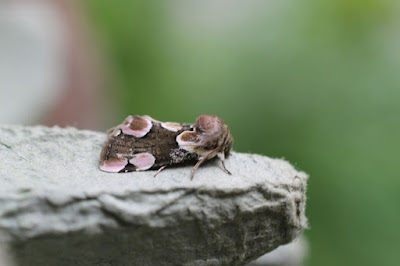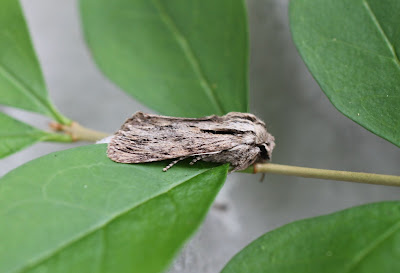Shandy Hall Moths

1 June 2019
1 June 2019 – Twenty-plume Moth
Twenty-plume Moth (Alucita hexadactyla) Apologies for the murky image of the Twenty-plume Moth (Alucita hexadactyla). My excuse is that I had to photograph it in a plastic tube as it is almost constantly in motion – little darting runs, one after another and no settling down into a resting position.This is only the third recorded at Shandy Hall, the last sighting being […]

27 May 2019
27 May 2019 – Moths Survive and Arrive
Peach Blossom (Thyatira batis) It is a wonder that this moth survives to fly into the trap. The pupa rests either on the soil (or just underneath) during the winter months and hatches to be on the wing in May. How such a delicate organism can survive on the surface of the soil is beyond […]

22 May 2019
22 May 2019 – Blondin of the Bushes II
Nemapotogon schwarziellus The photograph in the previous posting reveals that the measured moth is more likely to be what the Norfolk Moths website refers to as the Sandy Long-horn (Nemapotogon schwarziellus). Charlie Fletcher finds this variety more common than N swammerdammella – which is good news for Shandy Hall as it means that is another species to […]

21 May 2019
21 May 2019 – Blondin of the Bushes
(Nematopogon swammerdamella) Pure chance that I happened on this moth at 6.30pm as it rested on Hydrangea petiolaris – a climbing hydrangea that originates in Japan. The little moth has spectacular antennae and they seem to act like a tight-rope walker’s balancing pole as the insect clambers among the unopened flower heads. There has been only […]

14 May 2019
14 May 2019 – Studies in Grey
Muslin Moth (Diaphora mendica) The gap in posting does not represent idleness on my part. Traps have been set, Hebrew Characters (Orthosia gothica) have been identified and recorded but that is all. It is difficult to compose an account of the delights of moth-trapping when all there is to be seen is a moth that has been recorded […]

21 April 2019
21 April 2019 – Moth in Wolf’s Clothing
Brindled Beauty (Lycia hirtaria) It was a little premature to announce the appearance of the full moon on the occasion of the previous moth-trap. Good Friday was the correct date – and this moth and that date couldn’t be more appropriate. The Brindled Beauty (Lycia hirtaria) makes only its second appearance at Shandy Hall and […]

18 April 2019
18 April 2019 – The Cold Moon
Streamer (Anticlea derivata) Despite the heat of the day, the full moon and clear sky made the temperature drop last night and the 12 Hebrew Characters, a Satellite and this Streamer was the sum total to be found this morning. The Streamer has been trapped, identified, photographed and recorded already and this link will take […]

9 April 2019
9 April 2019 – The Missing Chestnut
Red Chestnut (Cerastis rubricosa) The Red Chestnut (Cerastis rubricosa) is new to the garden. It is a common moth and it is widespread throughout Yorkshire but it hadn’t been seen at Shandy Hall before. How can this be? Most probably because trapping tends not to be as active in this still chilly month. Last night’s […]

30 March 2019
30 March 2019 – Frosty Moths
Box of Moths Before setting up the moth trap last night I went to that trusty source of internet information known as Yorkshire Moths Flying Tonight. A list of possible moth-visitors to the gardens, woods, meadows and parks of this large county is there to refer to and I hoped that my memory might be […]

27 March 2019
27 March 2019 – Early Thorn
Early Thorn (Senaria dentaria) Too many delays (and too many chilly evenings) so far this year but finally one moth insists on drawing attention to the fact that there is increasing activity in the garden and it is time to see what the moth trap will reveal. Leaving the kitchen light on accidentally overnight attracted […]

26 October 2018
26 October 2018 – Dr Blair’s Moths
Blair’s Shoulder Knot (Lithophane leautieri) The Juniperus procumbens, growing near the base of the ancient sweet chestnut tree, is the possible food plant for this Blair’s Shoulder-knot when it was in the larval stage of its development. The pink flush on the abdomen can be seen quite easily as the moth’s defence response is to play dead […]

16 October 2018
16 October 2018 – Dickensian Sprawling
Sprawler (Asteroscopus sphinx) This is Sprawler. Also known as Asteroscopus sphinx and before that Petasia cassinea. The petasia part of the scientific name seems to come from ‘able to fly’ but this seems somewhat odd as the majority of moths manage this without any trouble; the sphinx part of its other identity refers to the larva’s […]
Recent Moths
- Rise of the AI Naturalist
- Best Moths for a Haunted Abbey
- The Real and Fake Deaths of Moths
- The Colonizers of Yorkshire
- Glamour in the Dark: Two Newcomers Arrive at Shandy Hall
- 25 July 2023 – Collective Noun for Hawkmoths
- MOTH LIST to August 2023 with links
- 28 July 2023 – TRIPLE New Species Alert!
- 18 July 2023 – A Golden…Plusia!
- 13 July 2023 – Arts and Sciences
- 10 July 2023 – Rise of the Yellow Underwings
- 4 July 2023 – Cold-weather Catch






